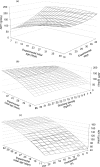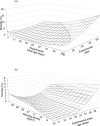Meta-analysis of the effects of intensive rearing environments on the performance and welfare of broiler chickens
- PMID: 29924356
- PMCID: PMC6162358
- DOI: 10.3382/ps/pey243
Meta-analysis of the effects of intensive rearing environments on the performance and welfare of broiler chickens
Abstract
To better understand how relevant intensive systems' characteristics simultaneously affect the performance and welfare of broiler chickens, a meta-analysis of recent literature was carried out. The study determined the effects of gender, genetics, experimental initial age (EIA, d), stocking density (SD; kg/m2), group size (GS; n), bedding material (yes/no), duration of photoperiod (DP; h), divided scotoperiod (yes/no), feeding phases (1/2/3/>3), environmental control (EC; yes/no), environmental enrichment (yes/no), use of vaccines and other medications (yes/no), experimental duration (d), and relevant 2-way interactions on average daily gain (g/d), average daily feed intake (g/d), FCR (g: g), mortality (%), behavior (%), and gait score (mean value). Predictive equations for response variables were calculated using multiple regression models including a random experiment effect. Among other results, EIA × SD interaction indicated that relatively high SD may improve FCR at older ages, but parallel increased mortality would pose concerns about the actual productive benefits and welfare. Combining large GS and relatively low SD seem to improve performance and decrease flock disturbance. They would also increase leg problems, and so their actual benefits on welfare remain unclear. A gradual increase in FCR seems to occur with longer DP at older EIA (EIA × DP interaction), highlighting the importance of adapting light programs to flock age to optimize performance. The SD × DP and GS × DP interactions predicted increased FCR for longer DP at low SD or large GS, that is, with more effective space available. Longer DP combined with low SD or large GS would overall promote enhanced leg conditions, and therefore welfare. Predictions would not support scotoperiod division from both performance and welfare perspectives. The SD × EC interaction indicated that EC would benefit chicken performance at low SD, although EC would seem to increase leg problems. Our study highlights the complex, interactive nature of production systems' characteristics on broiler chicken performance and welfare.
Figures








References
-
- Averós X., Brossard L., Dourmad J. Y., de Greef K., Edge H. L., Edwards S. A., Meunier-Salaün M. C.. 2010a. Quantitative assessment of the effects of space allowance, group size and floor characteristics on the lying behaviour of growing-finishing pigs. Animal 4:777–783. - PubMed
-
- Averós X., Brossard L., Dourmad J. Y., de Greef K., Edge H. L., Edwards S. A., Meunier-Salaün M. C.. 2010b. A meta-analysis of the combined effect of housing and environmental enrichment characteristics on the behaviour and performance of pigs. Appl. Anim. Behav. Sci. 127:73–85.
-
- Averós X., Brossard L., Dourmad J. Y., de Greef K. H., Edwards S. A. M. C. Meunier-Salaün. 2012. Meta-analysis on the effects of the physical environment, animal traits, feeder and feed characteristics on the feeding behaviour and performance of growing-finishing pigs. Animal 6:1275–1289. - PubMed
-
- Bayram A, S., Özkan. 2010. Effects of a 16-hour light, 8-hour dark lighting schedule on behavioral traits and performance in male broiler chickens. J. Appl. Poult. Res. 19:263–273.
-
- Bessei W. 2006. Welfare of broilers: a review. Worlds Poult. Sci. J. 62:455–466.
Publication types
MeSH terms
LinkOut - more resources
Full Text Sources
Other Literature Sources

